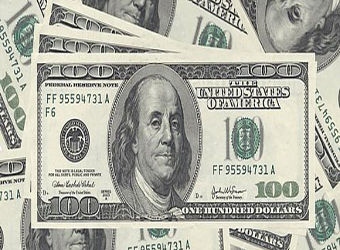U.S. dollar struggled on Monday, wallowing near a 2-1/2-year low against the euro, weighed down by U.S. political uncertainty and uninspiring U.S. data that added to doubts about whether there will be another Federal Reserve rate hike this year.
Growth in the world’s largest economy picked up to 2.6 percent in the second quarter, matching expectations of economists polled by Reuters, but growth in the first quarter was revised down to 1.2 percent.
U.S. labor costs also rose less than expected in the second quarter, data on Friday showed, adding to concerns that inflation will remain low.
“It is easy for uncertainty to increase about the Fed’s ability to raise rates next year if inflation remains low. We could see the dollar head below 110.00 yen under such circumstances,” said Junichi Ishikawa, senior forex strategist at IG Securities in Tokyo.
Deepening U.S. political uncertainty was also expected to keep the greenback on the defensive.
President Donald Trump on Friday replaced his White House chief of staff, Reince Priebus, installing retired General John Kelly in his place, in a major shake-up of his top team.
“The replacement of Priebus could be a turning point for the Trump administration. ‘Trump risk’ could now begin to take its toll on U.S. equities, which have been doing well until now, and in turn weigh on the dollar,” Ishikawa at IG Securities said.
Hopes that the Trump administration will implement tax reforms and economic stimulus in the near future, seen as dollar-positive factors, also faded after the U.S. Senate on Friday failed to dismantle Obamacare, in another political setback for the president. The euro was a shade lower at $1.1732 but remained in striking distance of $1.1777, its strongest level since January 2015 set on Thursday.
The euro was a shade lower at $1.1732 but remained in striking distance of $1.1777, its strongest level since January 2015 set on Thursday.
The U.S. currency was down 0.1 percent at 110.570 yen after touching 110.300 earlier in the session, its weakest since mid-June.
“The dollar is capped firmly by the perception that U.S. yields won’t be able to rise any time soon,” said Koji Fukaya, president of FPG Securities in Tokyo.
The ten-year Treasury yield stretched Friday’s decline and touched 2.273 percent, its lowest in nearly a week.
“The Fed has been labelled as dovish after last week’s policy meeting. Idon’t necessarily agree with such a view but this is the understanding that is now holding sway in the market and the dollar has weakened steadily.”
The U.S. central bank said last week it expected to start winding down its massive holdings of bonds “relatively soon.” It also noted that both overall inflation and a measure of underlying price gains had declined and said it would “carefully monitor” price trends.
The dollar index, which tracks the U.S. currency against a basket of six major rivals, was 0.2 percent higher at 93.450, trimming some losses after dropping 0.6 percent on Friday.
The pound was little changed at $1.3124 and in close reach of a 10-month high of $1.3159 scaled on Thursday. Sterling has been buoyant against the broadly weaker dollar, supported by hopes that Britain will exit the European Union under a transitional deal.
The Canadian dollar was down 0.4 percent at C$1.2477 per dollar, having lost a bit of steam after rallying Friday on robust local growth data which fanned expectations the Bank of Canada will again raise interest rates.
The loonie had advanced to C$1.2420 per dollar on Friday, nearing a two-year peak of C$1.2414 touched on Thursday.
Source: Reuters



